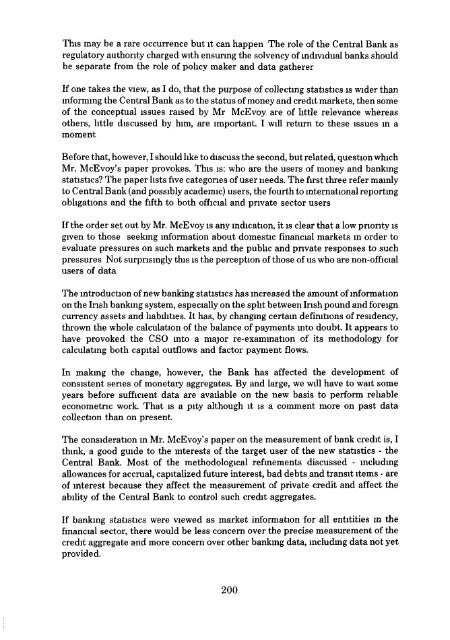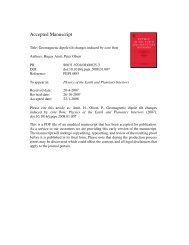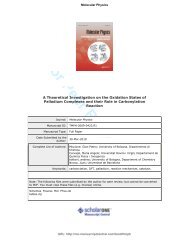parti: objectives and features of the new reporting system 159 - TARA
parti: objectives and features of the new reporting system 159 - TARA
parti: objectives and features of the new reporting system 159 - TARA
Create successful ePaper yourself
Turn your PDF publications into a flip-book with our unique Google optimized e-Paper software.
This may be a rare occurrence but it can happen The role <strong>of</strong> <strong>the</strong> Central Bank as<br />
regulatory authority charged with ensuring <strong>the</strong> solvency <strong>of</strong> individual banks should<br />
be separate from <strong>the</strong> role <strong>of</strong> policy maker <strong>and</strong> data ga<strong>the</strong>rer<br />
If one takes <strong>the</strong> view, as I do, that <strong>the</strong> purpose <strong>of</strong> collecting statistics is wider than<br />
informing <strong>the</strong> Central Bank as to <strong>the</strong> status <strong>of</strong> money <strong>and</strong> credit markets, <strong>the</strong>n some<br />
<strong>of</strong> <strong>the</strong> conceptual issues raised by Mr McEvoy are <strong>of</strong> little relevance whereas<br />
o<strong>the</strong>rs, little discussed by him, are important. I will return to <strong>the</strong>se issues m a<br />
moment<br />
Before that, however, I should like to discuss <strong>the</strong> second, but related, question which<br />
Mr. McEvoy's paper provokes. This is: who are <strong>the</strong> users <strong>of</strong> money <strong>and</strong> banking<br />
statistics? The paper lists five categories <strong>of</strong> user needs. The first three refer mainly<br />
to Central Bank (<strong>and</strong> possibly academic) users, <strong>the</strong> fourth to international <strong>reporting</strong><br />
obligations <strong>and</strong> <strong>the</strong> fifth to both <strong>of</strong>ficial <strong>and</strong> private sector users<br />
If <strong>the</strong> order set out by Mr. McEvoy is any indication, it is clear that a low priority is<br />
given to those seeking information about domestic financial markets m order to<br />
evaluate pressures on such markets <strong>and</strong> <strong>the</strong> public <strong>and</strong> private responses to such<br />
pressures Not surprisingly this is <strong>the</strong> perception <strong>of</strong> those <strong>of</strong> us who are non-<strong>of</strong>ficial<br />
users <strong>of</strong> data<br />
The introduction <strong>of</strong> <strong>new</strong> banking statistics has increased <strong>the</strong> amount <strong>of</strong> information<br />
on <strong>the</strong> Irish banking <strong>system</strong>, especially on <strong>the</strong> split between Irish pound <strong>and</strong> foreign<br />
currency assets <strong>and</strong> liabilities. It has, by changing certain definitions <strong>of</strong> residency,<br />
thrown <strong>the</strong> whole calculation <strong>of</strong> <strong>the</strong> balance <strong>of</strong> payments into doubt. It appears to<br />
have provoked <strong>the</strong> CSO into a major re-examination <strong>of</strong> its methodology for<br />
calculating both capital outflows <strong>and</strong> factor payment flows.<br />
In making <strong>the</strong> change, however, <strong>the</strong> Bank has affected <strong>the</strong> development <strong>of</strong><br />
consistent series <strong>of</strong> monetary aggregates. By <strong>and</strong> large, we will have to wait some<br />
years before sufficient data are available on <strong>the</strong> <strong>new</strong> basis to perform reliable<br />
econometric work. That is a pity although it is a comment more on past data<br />
collection than on present.<br />
The consideration in Mr. McEvoy's paper on <strong>the</strong> measurement <strong>of</strong> bank credit is, I<br />
think, a good guide to <strong>the</strong> interests <strong>of</strong> <strong>the</strong> target user <strong>of</strong> <strong>the</strong> <strong>new</strong> statistics - <strong>the</strong><br />
Central Bank. Most <strong>of</strong> <strong>the</strong> methodological refinements discussed - including<br />
allowances for accrual, capitalized future interest, bad debts <strong>and</strong> transit items - are<br />
<strong>of</strong> interest because <strong>the</strong>y affect <strong>the</strong> measurement <strong>of</strong> private credit <strong>and</strong> affect <strong>the</strong><br />
ability <strong>of</strong> <strong>the</strong> Central Bank to control such credit aggregates.<br />
If banking statistics were viewed as market information for all entitities in <strong>the</strong><br />
financial sector, <strong>the</strong>re would be less concern over <strong>the</strong> precise measurement <strong>of</strong> <strong>the</strong><br />
credit aggregate <strong>and</strong> more concern over o<strong>the</strong>r banking data, including data not yet<br />
provided.<br />
200
















